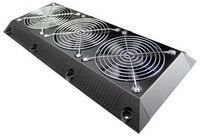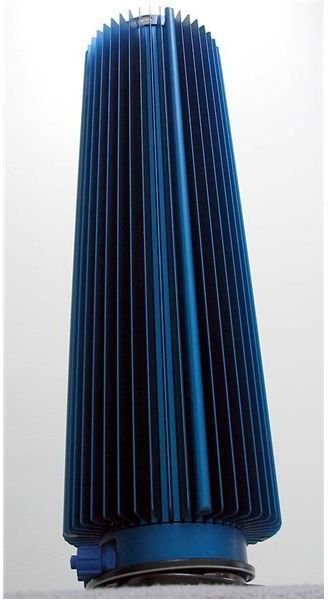PC Liquid Cooling System Radiators
Overview
It could be said that the radiator is the most important part of any liquid cooling system. Of course that isn’t true, since every single component is absolutely crucial for operation. A more accurate statement would be that the radiator’s design, quality, and location have the largest impact on the system as a whole.
What about the radiator makes it so special? In the circulating flow of a liquid cooling system, the radiator offers the only point at which the liquid can shed heat. It picks up heat from the water blocks, contains it as it runs through stifling plastic tubing, stews a bit in the reservoir, and stops by the pump not even long enough for a hello and a handshake. When it runs through the radiator, though, the maximum surface area exposure, contact with metals designed to pull away heat, and long chain of tubing it spends a considerable amount of time running through allows the hot fluid to cool back down to as low as room temperature.
Radiators come in a variety of designs for use with varying setups. Which you choose is dependant on whether you want the radiator inside the case, outside the case, or on your desk.
Radiators Inside the Chassis
Most liquid cooling system kits, and many other individually sold radiators, are designed to be mounted inside of the computer case. Some of these come with fans or can have a fan mounted to them and others do not. There is an innate problem with internal radiators, however. It’s a strange irony that liquid cooling typically requires air cooling in order to function. This is the purpose that the radiator and optional fan serve. The fact is, though, that standard liquid cooling systems that use air radiators (as opposed to a modified air conditioning or refrigeration unit that uses a chemical such as Freon) can not cool below what we call the “ambient” temperature. The ambient temperature is, essentially, the temperature of the air around the radiator. If your radiator were mounted externally, we could just call ambient “room temperature”. However, when the radiator is installed inside of the chassis, the combination of heat producing components creates a drastically higher ambient temperature.
The other potential problem with internally mounted radiators is the space constraints of many cases. If it isn’t a well designed full tower, chances are you won’t be able to install an average radiator inside of it.
Radiators Outside the Chassis

A popular solution to the ambient temperature and space constraint issues is installing the radiator somewhere on the outside of the case, like on the back, side panel, or on top. Regardless of where you put it, you have to make sure you have a case or expansion slot cover designed to allow the tubing to exit and re-enter the case.
The problem with an externally mounted radiator is usually only an aesthetic one. While some may find tubing snaking in and out of their PC’s chassis to be cool or exotic looking, others just find it to be extremely tacky - especially if, for example, a wide format radiator is installed perpendicular to the case’s innate lines and hangs off each edge like a stunningly poor attempt at a cross.
Desktop Radiators

There aren’t very many radiators designed specifically for liquid cooling systems that sit on your floor or desk. One extremely popular, and quite nifty looking choice is the Zalman Reserator pictured here. This unit also includes the cooling system’s reservoir and pump, making it a fantastic choice for minimizing cost and space usage of components.
Other radiators designed for different purposes have been used as floor or desk units for a liquid cooling system, but they have to be highly modified with various fittings and oftentimes welding in order to serve their purpose half as well as the commercially available Zalman. There used to be more of a variety of desk or floor unit radiators available, but most seem to have disappeared. Perhaps some day another will rise to challenge the Zalman’s rulership of the market, but for now the blue or black passively cooled beast is your best bet.
This post is part of the series: PC Liquid Cooling for Beginners
There are a lot of things that go into utilizing liquid cooling in your desktop PC. We break it down and make it possible for even a beginner to build their own liquid cooling solution that works perfectly for them.
